Ultrafast Laser Processing of Optical Fibers for Sensing Applications
Abstract
1. Introduction
2. Through-the-Coating Fiber Bragg Gratings
2.1. Ultraviolet vs. Infrared Femtosecond Irradiation
2.2. Point-by-Point Femtosecond FBG Inscription Process
2.3. Phase Mask Technique for Femtosecond FBG Inscription
2.3.1. Longitudinal and Transverse Walk-Off
2.3.2. Focal Spot Minimization
2.3.3. Tilted TTC-FBGs
2.3.4. FBGs with Ultra-Strong Cladding Modes
2.3.5. TTC-Written FBGs for Environmental Sensing Applications (Optical Trigger)
3. Femtosecond Laser-Enhanced Fiber Scattering: Random Fiber Gratings
3.1. Femtosecond Laser Fabrication of RFGs
3.2. Applications of RFGs
3.2.1. Distributed Sensing
3.2.2. Multi-Parameter Sensing Based on RFGs
3.2.3. High Frequncy Ultrasound Sensing Based on RFGs
3.2.4. Random Fiber Lasers
4. Conclusions
Funding
Conflicts of Interest
References
- Mihailov, S.J.; Grobnic, D.; Hnatovsky, C.; Walker, R.B.; Lu, P.; Coulas, D.; Ding, H. Extreme Environment Sensing Using Femtosecond Laser-Inscribed Fiber Bragg Gratings. Sensors 2017, 17, 2909. [Google Scholar] [CrossRef] [PubMed]
- Stuart, B.C.; Feit, M.D.; Herman, S.; Rubenchik, A.M.; Shore, B.W.; Perry, M.D. Optical ablation by high-power short-pulse lasers. J. Opt. Soc. Am. B 1996, 13, 459–468. [Google Scholar] [CrossRef]
- Schaffer, C.B.; Brodeur, A.; Mazur, E. Laser-induced breakdown and damage in bulk transparent materials induced by tightly focused femtosecond laser pulses. Meas. Sci. Technol. 2001, 12, 1784–1794. [Google Scholar] [CrossRef]
- Shimotsuma, Y.; Kazansky, P.G.; Qiu, J.; Hirao, K. Self-Organized Nanogratings in Glass Irradiated by Ultrashort Light Pulses. Phys. Rev. Lett. 2003, 91, 247405. [Google Scholar] [CrossRef]
- Bhardwaj, V.R.; Simova, E.; Rajeev, P.P.; Hnatovsky, C.; Taylor, R.S.; Rayner, D.M.; Corkum, P.B. Optically Produced Arrays of Planar Nanostructures inside Fused Silica. Phys. Rev. Lett. 2006, 96, 057404. [Google Scholar] [CrossRef]
- Glezer, E.N.; Mazur, E. Ultrafast-laser driven micro-explosions in transparent materials. Appl. Phys. Lett. 1997, 71, 882–884. [Google Scholar] [CrossRef]
- Juodkazis, S.; Misawa, H.; Hashimoto, T.; Gamaly, E.G.; Luther-Davies, B. Laser-induced microexplosion confined in a bulk of silica: Formation of nanovoids. Appl. Phys. Lett. 2006, 88, 201909. [Google Scholar] [CrossRef]
- Mihailov, S.J. Fiber Bragg Grating Sensors for Harsh Environments. Sensors 2012, 12, 1898–1918. [Google Scholar] [CrossRef]
- Lu, P.; Mihailov, S.J.; Coulas, D.; Ding, H.; Bao, X. Low-Loss Random Fiber Gratings Made with an fs-IR Laser for Distributed Fiber Sensing. J. Light. Technol. 2019, 37, 4697–4702. [Google Scholar] [CrossRef]
- Lee, K.K.; Mariampillai, A.; Haque, M.; Standish, B.A.; Yang, V.X.; Herman, P.R. Temperature-compensated fiber-optic 3D shape sensor based on femtosecond laser direct-written Bragg grating waveguides. Opt. Express 2013, 21, 24076–24086. [Google Scholar] [CrossRef] [PubMed]
- Waltermann, C.; Doering, A.; Köhring, M.; Angelmahr, M.; Schade, W. Cladding waveguide gratings in standard single-mode fiber for 3D shape sensing. Opt. Lett. 2015, 40, 3109–3112. [Google Scholar] [CrossRef]
- Janik, M.; Koba, M.; Celebańska, A.; Bock, W.J.; Śmietana, M. Sensing properties of micro-cavity in-line Mach-Zehnder inter-ferometer enhanced by reactive ion etching. Opt. Las. Technol. 2018, 103, 260–266. [Google Scholar] [CrossRef]
- Hill, K.; Meltz, G. Fiber Bragg grating technology fundamentals and overview. J. Light. Technol. 1997, 15, 1263–1276. [Google Scholar] [CrossRef]
- Douay, M.; Taunay, T.; Bernage, P.; Niay, P.; Cordier, P.; Dong, L.; Poignant, H.; Delevaque, E.; Xie, W.; Poumellec, B.; et al. Densification involved in the UV-based photosensitivity of silica glasses and optical fibers. J. Light. Technol. 1997, 15, 1329–1342. [Google Scholar] [CrossRef]
- Erdogan, T.; Mizrahi, V.; Lemaire, P.J.; Monroe, D. Decay of ultraviolet-induced fiber Bragg gratings. J. Appl. Phys. 1994, 76, 73–80. [Google Scholar] [CrossRef]
- Martinez, A.; Dubov, M.; Khrushchev, I.; Bennion, I. Direct writing of fibre Bragg gratings by femtosecond laser. Electron. Lett. 2004, 40, 1170. [Google Scholar] [CrossRef]
- Martinez, A.; Khrushchev, I.Y.; Bennion, I. Direct inscription of Bragg gratings in coated fibers by an infrared femtosecond laser. Opt. Lett. 2006, 31, 1603–1605. [Google Scholar] [CrossRef]
- Mihailov, S.J.; Smelser, C.W.; Lu, P.; Walker, R.B.; Grobnic, D.; Ding, H.; Henderson, G.; Unruh, J. Fiber Bragg gratings made with a phase mask and 800-nm femtosecond radiation. Opt. Lett. 2003, 28, 995–997. [Google Scholar] [CrossRef] [PubMed]
- Smelser, C.W.; Grobnic, D.; Mihailov, S.J. Generation of pure two-beam interference grating structures in an optical fiber with a femtosecond infrared source and a phase mask. Opt. Lett. 2004, 29, 1730–1732. [Google Scholar] [CrossRef]
- Abdukerim, N.; Grobnic, D.; Lausten, R.; Hnatovsky, C.; Mihailov, S.J. Complex diffraction and dispersion effects in femto-second laser writing of fiber Bragg gratings using the phase mask technique. Opt. Express 2019, 27, 32536–32555. [Google Scholar] [CrossRef] [PubMed]
- Mills, J.D.; Hillman, C.W.J.; Blott, B.H.; Brocklesby, W.S. Imaging of free-space interference patterns used to manufacture fiber Bragg gratings. Appl. Opt. 2000, 39, 6128–6135. [Google Scholar] [CrossRef]
- Smelser, C.W.; Mihailov, S.J.; Grobnic, D.; Lu, P.; Walker, R.B.; Ding, H.; Dai, X. Multiple-beam interference patterns in optical fiber generated with ultrafast pulses and a phase mask. Opt. Lett. 2004, 29, 1458–1460. [Google Scholar] [CrossRef] [PubMed]
- Hnatovsky, C.; Grobnic, D.; Mihailov, S.J. Nonlinear photoluminescence imaging applied to femtosecond laser manufacturing of fiber Bragg gratings. Opt. Express 2017, 25, 14247. [Google Scholar] [CrossRef] [PubMed]
- Born, M.; Wolf, E. Principles of Optics: Electromagnetic Theory of Propagation, Interference, and Diffraction of Light, 6th ed.; Per-gamon: Oxford, UK, 1980. [Google Scholar]
- Mihailov, S.; Grobnic, D.; Smelser, C. Efficient grating writing through fibre coating with femtosecond IR radiation and phase mask. Electron. Lett. 2007, 43, 442. [Google Scholar] [CrossRef]
- Bernier, M.; Trépanier, F.; Carrier, J.; Vallée, R. High mechanical strength fiber Bragg gratings made with infrared femtosecond pulses and a phase mask. Opt. Lett. 2014, 39, 3646–3649. [Google Scholar] [CrossRef]
- Grobnic, D.; Hnatovsky, C.; Mihailov, S.J. Thermally Stable Type II FBGs Written through Polyimide Coatings of Silica-Based Optical Fiber. IEEE Photon-Technol. Lett. 2017, 29, 1780–1783. [Google Scholar] [CrossRef]
- Hnatovsky, C.; Grobnic, D.; Mihailov, S.J.; Mihailov, D.G.A.S.J. Through-the-coating femtosecond laser inscription of very short fiber Bragg gratings for acoustic and high temperature sensing applications. Opt. Express 2017, 25, 25435. [Google Scholar] [CrossRef] [PubMed]
- Habel, J.; Boilard, T.; Frenière, J.-S.; Trépanier, F.; Bernier, M. Femtosecond FBG written through the coating for sensing ap-plications. Sensors 2017, 17, 2519. [Google Scholar] [CrossRef] [PubMed]
- Albert, J.; Shao, L.-Y.; Caucheteur, C. Tilted fiber Bragg grating sensors. Laser Photon-Rev. 2012, 7, 83–108. [Google Scholar] [CrossRef]
- Abdukerim, N.; Grobnic, D.; Hnatovsky, C.; Mihailov, S.J. Through-the-coating writing of tilted fiber Bragg gratings with the phase mask technique. Opt. Express 2019, 27, 38259–38269. [Google Scholar] [CrossRef] [PubMed]
- Ioannou, A.; Theodosiou, A.; Caucheteur, C.; Kalli, K. Direct writing of plane-by-plane tilted fiber Bragg gratings using a femtosecond laser. Opt. Lett. 2017, 42, 5198–5201. [Google Scholar] [CrossRef] [PubMed]
- Wang, R.; Si, J.; Chen, T.; Yan, L.; Cao, H.; Pham, X.; Hou, X. Fabrication of high-temperature tilted fiber Bragg gratings using a femtosecond laser. Opt. Express 2017, 25, 23684–23689. [Google Scholar] [CrossRef] [PubMed]
- Smelser, C.W.; Mihailov, S.J.; Grobnic, D. Formation of Type I-IR and Type II-IR gratings with an ultrafast IR laser and a phase mask. Opt. Express 2005, 13, 5377–5386. [Google Scholar] [CrossRef] [PubMed]
- Thomas, J.; Jovanovic, N.; Becker, R.G.; Marshall, G.D.; Withford, M.J.; Tünnermann, A.; Nolte, S.; Steel, M.J. Cladding mode coupling in highly localized fiber Bragg gratings: Modal properties and transmission spectra. Opt. Express 2010, 19, 325–341. [Google Scholar] [CrossRef] [PubMed]
- Thomas, J.U.; Jovanovic, N.; Krämer, R.G.; Marshall, G.D.; Withford, M.J.; Tünnermann, A.; Nolte, S.; Steel, M.J. Cladding mode coupling in highly localized fiber Bragg gratings II: Complete vectorial analysis. Opt. Express 2012, 20, 21434–21449. [Google Scholar] [CrossRef]
- Abdukerim, N.; Grobnic, D.; Hnatovsky, C.; Mihailov, S.J. High temperature stable fiber Bragg gratings with ultrastong cladding modes written using the phase mask technique and an infrared femtosecond laser. Opt. Lett. 2020, 45, 443–446. [Google Scholar] [CrossRef]
- Walker, R.B.; Grobnic, D.; Mihailov, S.J.; Lu, P. High temperature multiparameter sensor. SPIE OPTO 2011, 7934, 79340. [Google Scholar] [CrossRef]
- Lopez, J.D.; Dante, A.; Cremonezi, A.O.; Bacurau, R.M.; Carvalho, C.C.; Allil, R.C.D.S.B.; Ferreira, E.C.; Werneck, M.M. Fiber-Optic Current Sensor Based on FBG and Terfenol-D with Magnetic Flux Concentration for Enhanced Sensitivity and Linearity. IEEE Sens. J. 2020, 20, 3572–3578. [Google Scholar] [CrossRef]
- Spirin, V.; Shlyagin, M.; Miridonov, S.; Jiménez, F.; Gutiérrez, R. Fiber Bragg grating sensor for petroleum hydrocarbon leak detection. Opt. Lasers Eng. 1999, 32, 497–503. [Google Scholar] [CrossRef]
- Lu, P.; Mihailov, S.J.; Ding, H.; Grobnic, D.; Walker, R.B.; Coulas, D.; Hnatovsky, C.; Naumov, A.Y. Plane-by-Plane Inscription of Grating Structures in Optical Fibers. J. Light. Technol. 2018, 36, 926–931. [Google Scholar] [CrossRef]
- Derevyanko, S. Design of a flat-top fiber Bragg filter via quasi-random modulation of the refractive index. Opt. Lett. 2008, 33, 2404–2406. [Google Scholar] [CrossRef] [PubMed]
- Yin, H.; Gbadebo, A.; Turitsyna, E.G. Top-hat random fiber grating. Opt. Lett. 2015, 40, 3592–3594. [Google Scholar] [CrossRef]
- Loranger, S.; Gagné, M.; Lambin-Iezzi, V.; Kashyap, R. Rayleigh scatter based order of magnitude increase in distributed temperature and strain sensing by simple UV exposure of optical fibre. Sci. Rep. 2015, 5, 11177. [Google Scholar] [CrossRef] [PubMed]
- Yan, Y.; Huang, S.; Li, S.; Chen, R.; Ohodnicki, P.; Buric, M.; Lee, S.; Li, M.; Chen, K.P. Distributed optical fiber sensors with ultrafast laser enhanced Rayleigh backscattering profiles for real-time monitoring of solid oxide fuel cell operations. Sci. Rep. 2017, 7, 9360. [Google Scholar] [CrossRef] [PubMed]
- Churkin, D.V.; Sugavanam, S.; Vatnik, I.D.; Wang, Z.; Podivilov, E.V.; Babin, S.A.; Rao, Y.; Turitsyn, S.K. Recent advances in fundamentals and applications of random fiber lasers. Adv. Opt. Photon. 2015, 7, 516–569. [Google Scholar] [CrossRef]
- Li, Y.; Lu, P.; Bao, X.; Ou, Z. Random spaced index modulation for a narrow linewidth tunable fiber laser with low intensity noise. Opt. Lett. 2014, 39, 2294–2297. [Google Scholar] [CrossRef]
- Li, Y.; Lu, P.; Baset, F.; Ou, Z.; Song, J.; Alshehri, A.; Bhardwaj, V.R.; Bao, X. Narrow linewidth low frequency noise Er-doped fiber ring laser based on femtosecond laser induced random feedback. Appl. Phys. Lett. 2014, 105, 101105. [Google Scholar] [CrossRef]
- Xu, Y.; Zhang, M.; Lu, P.; Mihailov, S.; Bao, X. Multi-parameter sensor based on random fiber lasers. AIP Adv. 2016, 6, 095009. [Google Scholar] [CrossRef]
- Xu, Y.; Zhang, L.; Gao, S.; Lu, P.; Mihailov, S.; Bao, X. Highly sensitive fiber random-grating-based random laser sensor for ultrasound detection. Opt. Lett. 2017, 42, 1353–1356. [Google Scholar] [CrossRef]
- Zhang, L.; Lu, P.; Zhou, Z.; Wang, Y.; Mihailov, S.; Chen, L.; Bao, X. High-Efficiency Random Fiber Laser Based on Strong Random Fiber Grating for MHz Ultrasonic Sensing. IEEE Sens. J. 2020, 20, 5885–5892. [Google Scholar] [CrossRef]
- Xu, Y.; Lu, P.; Mihailov, S.; Bao, X. Real-time physical random bit generation at Gbps based on random fiber lasers. Opt. Lett. 2017, 42, 4796–4799. [Google Scholar] [CrossRef] [PubMed]
- Boiarski, A.A.; Pilate, G.; Fink, T.; Nilsson, N. Temperature measurements in power plant equipment using distributed fiber optic sensing. IEEE Trans. Power Delivery 1995, 10, 1771–1778. [Google Scholar] [CrossRef]
- Froggatt, M.; Moore, J. High-spatial-resolution distributed strain measurement in optical fiber with Rayleigh scatter. Appl. Opt. 1998, 37, 1735–1740. [Google Scholar] [CrossRef] [PubMed]
- Kreger, S.T.; Gifford, D.K.; Froggatt, M.E.; Soller, B.J.; Wolfe, M.S. High resolution distributed strain or temperature meas-urements in single-and multi-mode fiber using swept-wavelength interferometry. In Proceedings of the Optical Fiber Sensors Conference, Cancun, Mexico, 23–27 October 2006; Optical Society of America: Washington, DC, USA, 2006. Paper ThE42. [Google Scholar]
- Babin, S.A. Random fiber laser based on Rayleigh scattering: Basic principles and experimental results. In Proceedings of the 2010 Photonics Global Conference, Singapore, 14–16 December 2010; pp. 1–5. [Google Scholar]
- Westbrook, P.S.; Feder, K.S.; Ortiz, R.M.; Kremp, T.; Monberg, E.M.; Wu, H.; Simoff, D.A.; Shenk, S. Kilometer length low loss enhanced back scattering fiber for distributed sensing. In Proceedings of the 25th International Conference on Optical Fiber Sensors, Jeju, Korea, 24–28 April 2017; Volume 10323, p. 103239Q. [Google Scholar]
- Zhou, K.; Dubov, M.; Mou, C.; Zhang, L.; Mezentsev, V.K.; Bennion, I. Line-by-Line Fiber Bragg Grating Made by Femtosecond Laser. IEEE Photon Technol. Lett. 2010, 22, 1190–1192. [Google Scholar] [CrossRef]
- Williams, R.J.; Krämer, R.G.; Nolte, S.; Withford, M.J. Femtosecond direct-writing of low-loss fiber Bragg grat-ings using a continuous core-scanning technique. Opt. Lett. 2013, 38, 1918–1929. [Google Scholar] [CrossRef]
- Xu, Y.; Lu, P.; Gao, S.; Xiang, D.; Mihailov, S.; Bao, X. Optical fiber random grating-based multiparameter sensor. Opt. Lett. 2015, 40, 5514–5517. [Google Scholar] [CrossRef]
- Jin, W.; Michie, W.C.; Thursby, G.; Konstantaki, M.; Culshaw, B. Simultaneous measurement of strain and temperature: Error analysis. Opt. Eng. 1997, 36, 598–610. [Google Scholar] [CrossRef]
- Xu, Y.; Gao, S.; Lu, P.; Mihailov, S.; Chen, L.; Bao, X. Low-noise Brillouin random fiber laser with a random grating-based resonator. Opt. Lett. 2016, 41, 3197–3200. [Google Scholar] [CrossRef]
- Xu, Y.; Zhang, M.; Zhang, L.; Lu, P.; Mihailov, S.; Bao, X. Time-delay signature suppression in a chaotic semiconductor laser by fiber random grating induced random distributed feedback. Opt. Lett. 2017, 42, 4107–4110. [Google Scholar] [CrossRef]
- Zhang, L.; Xu, Y.; Lu, P.; Mihailov, S.; Chen, L.; Bao, X. Multi-Wavelength Brillouin Random Fiber Laser via Distributed Feedback from a Random Fiber Grating. J. Light. Technol. 2018, 36, 2122–2128. [Google Scholar] [CrossRef]
- Zhou, Z.; Lu, P.; Zhang, L.; Mihailov, S.; Chen, L.; Bao, X. Thermal and acoustic noise insensitive Brillouin random fiber laser based on polarization-maintaining random fiber grating. Opt. Lett. 2019, 44, 4195–4198. [Google Scholar] [CrossRef] [PubMed]
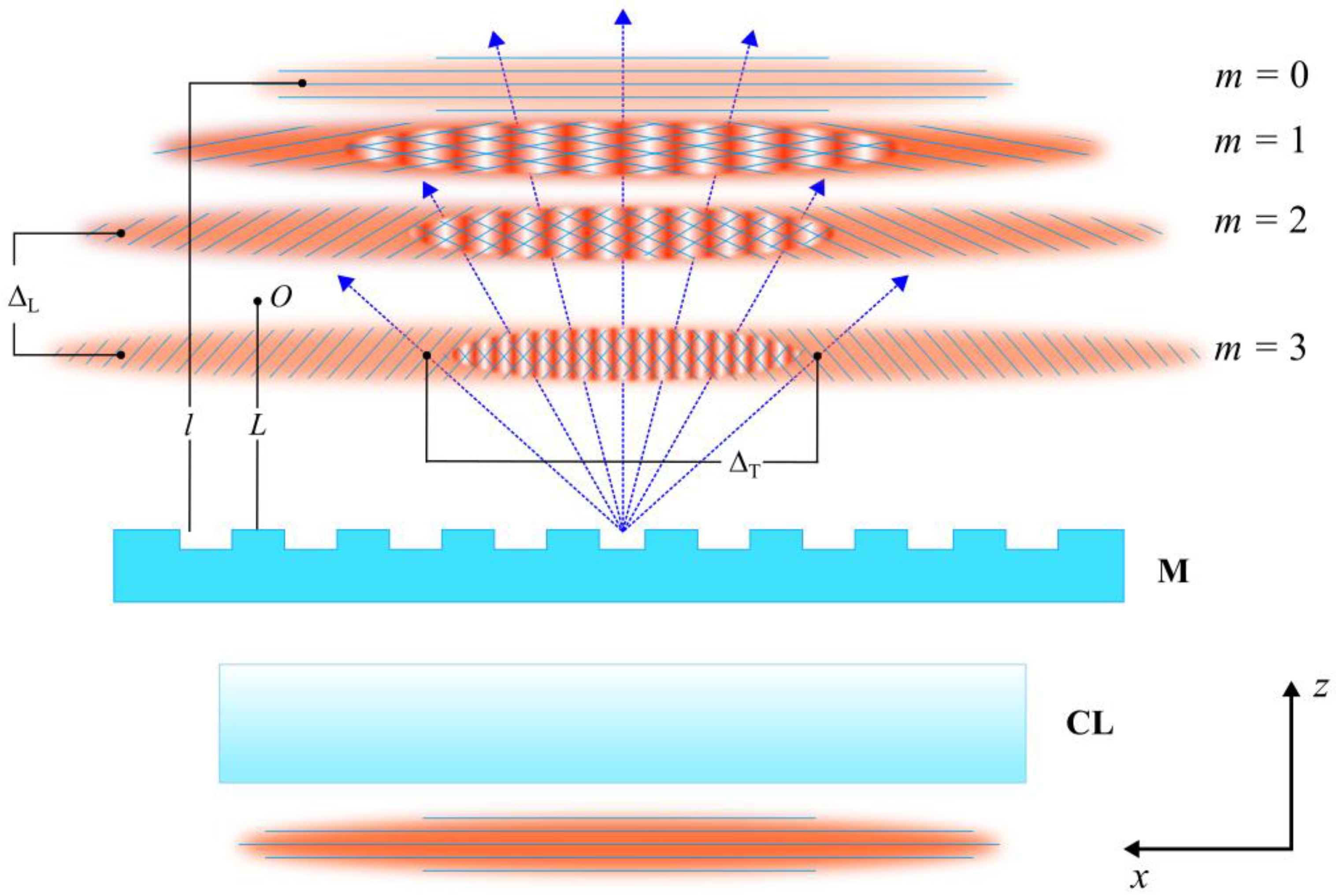

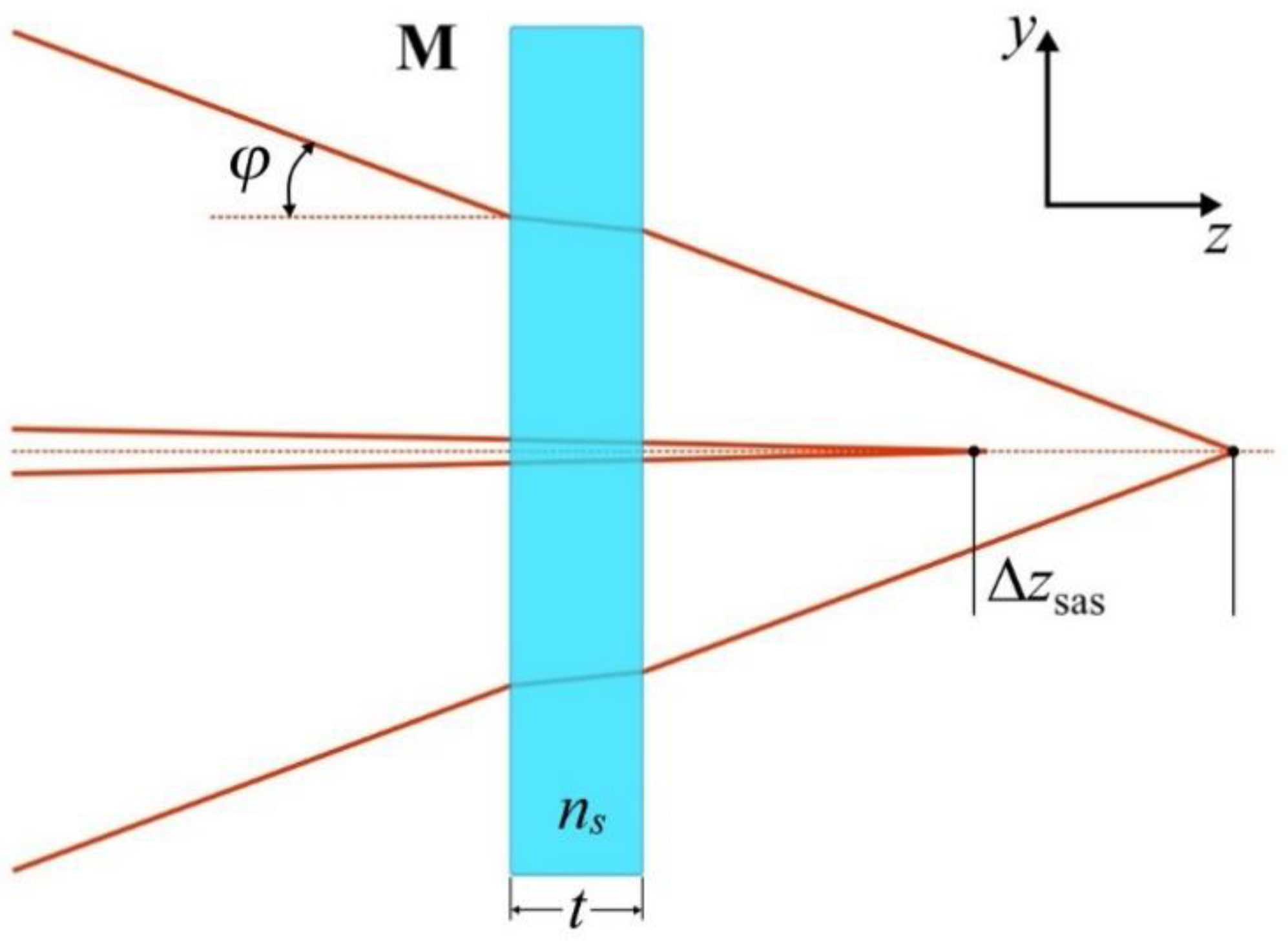
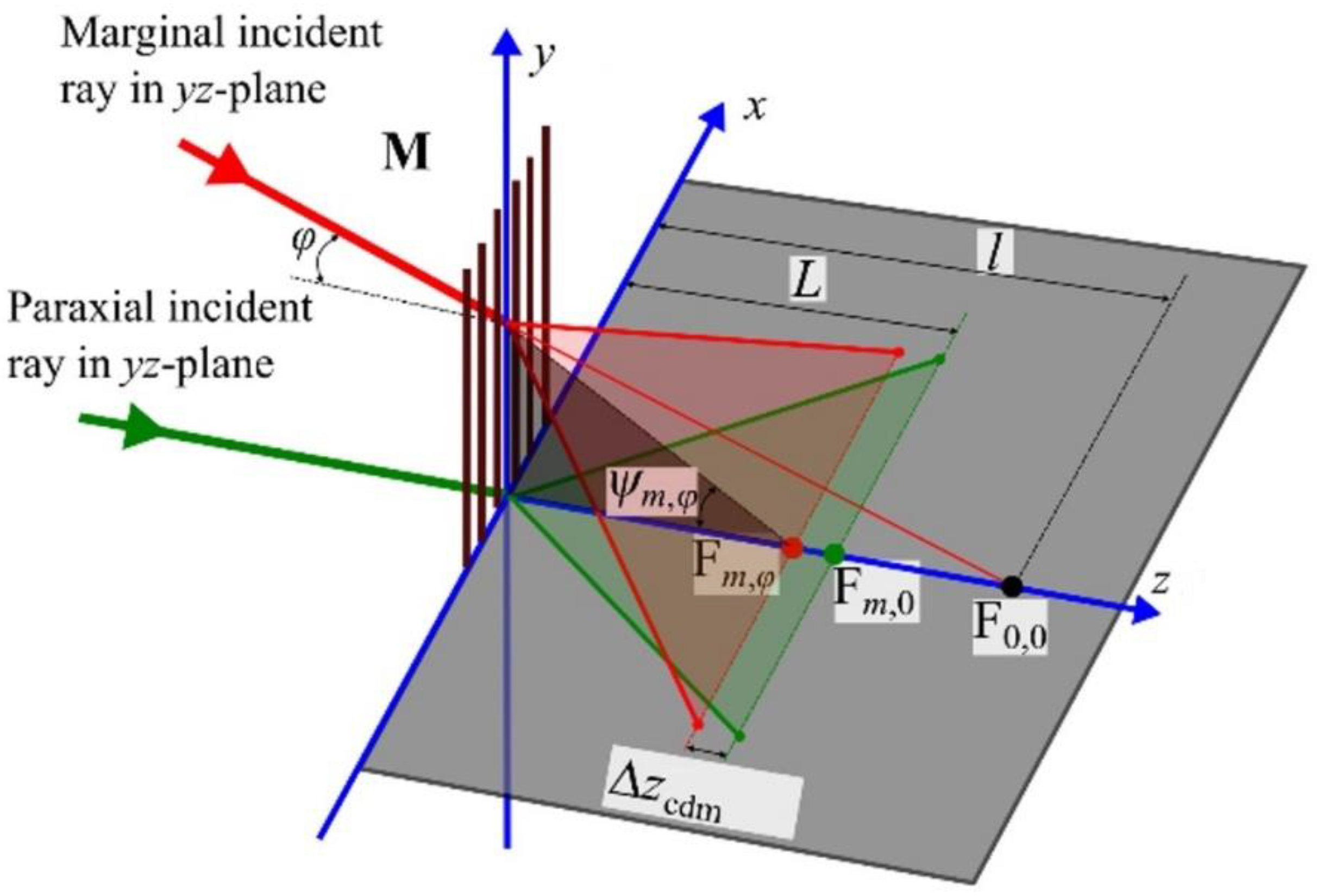



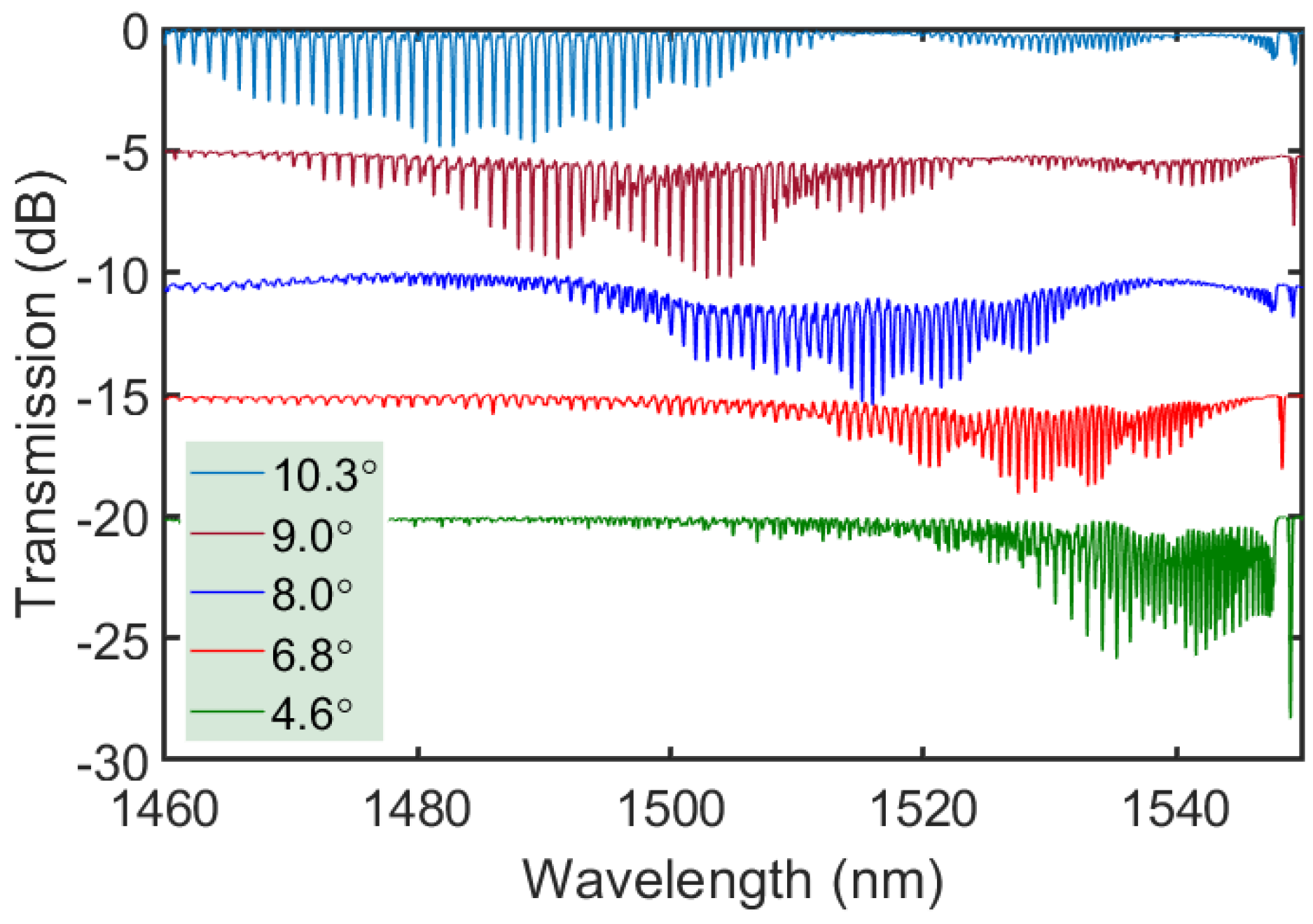
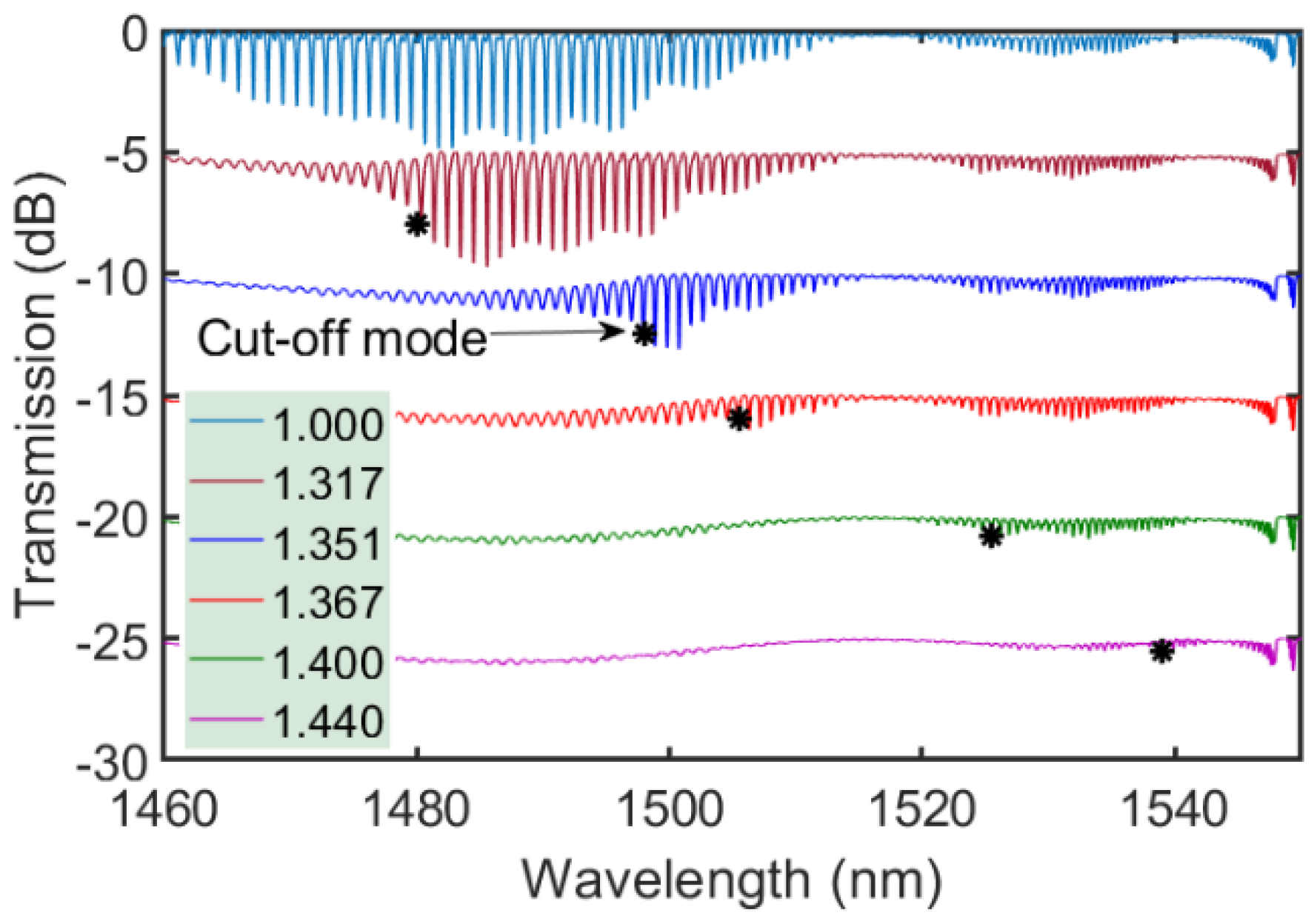
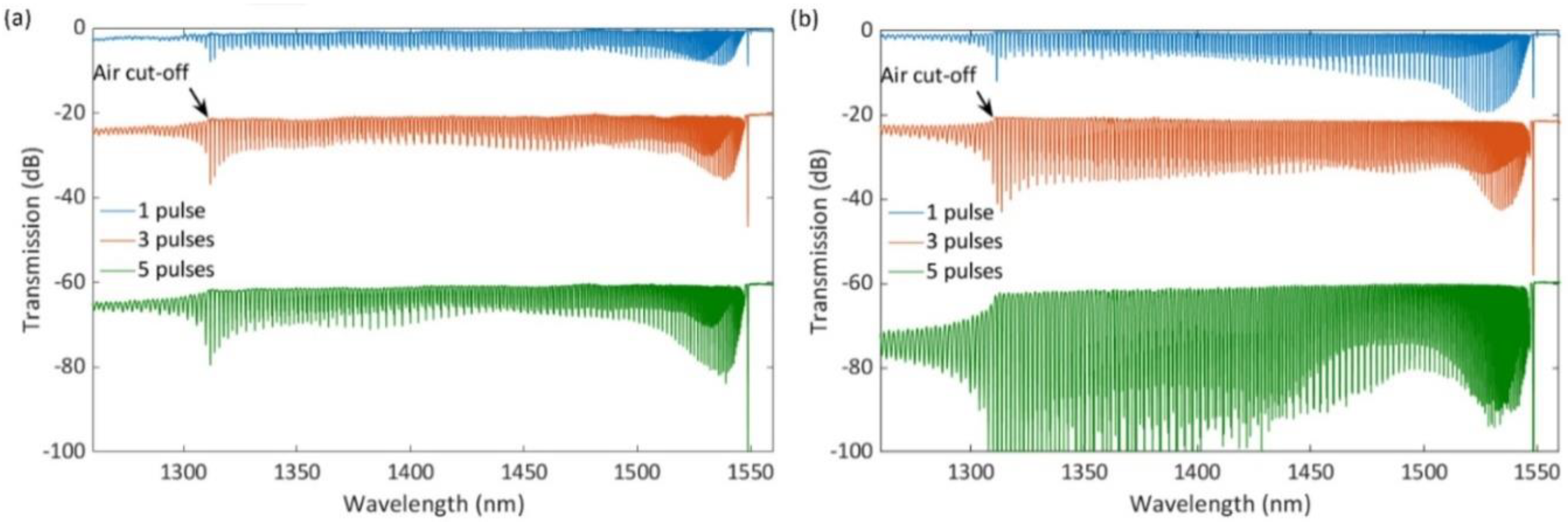

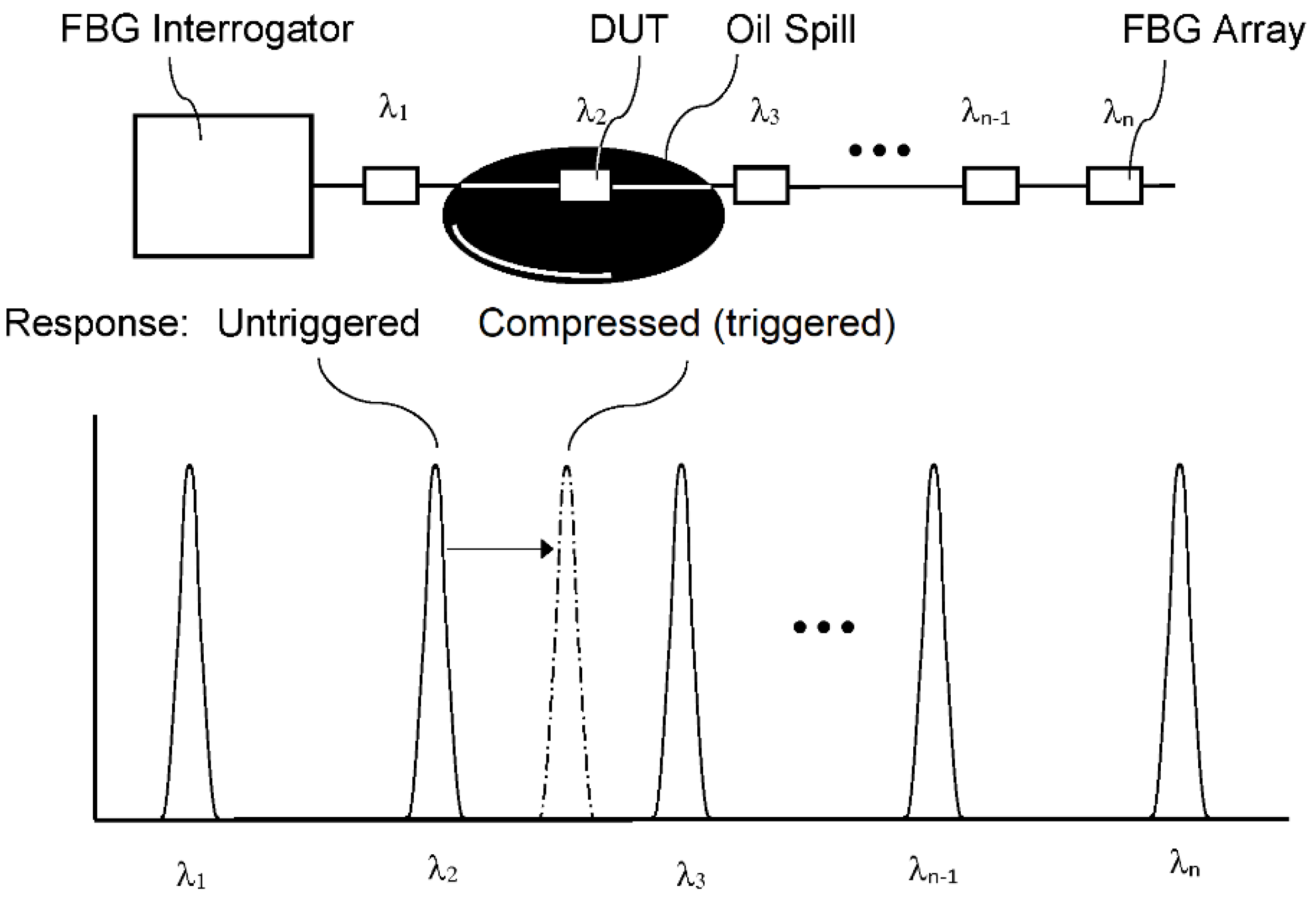

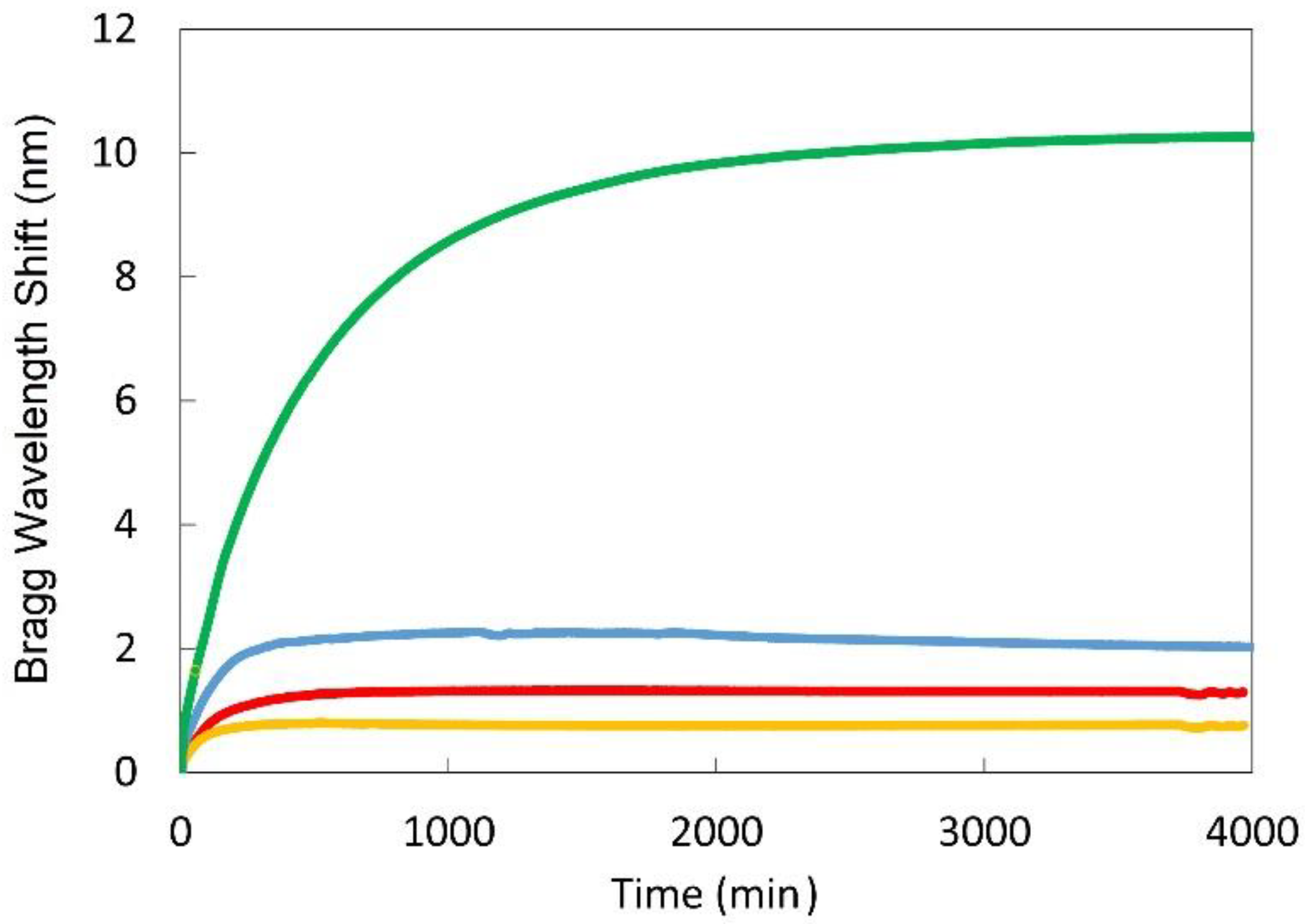
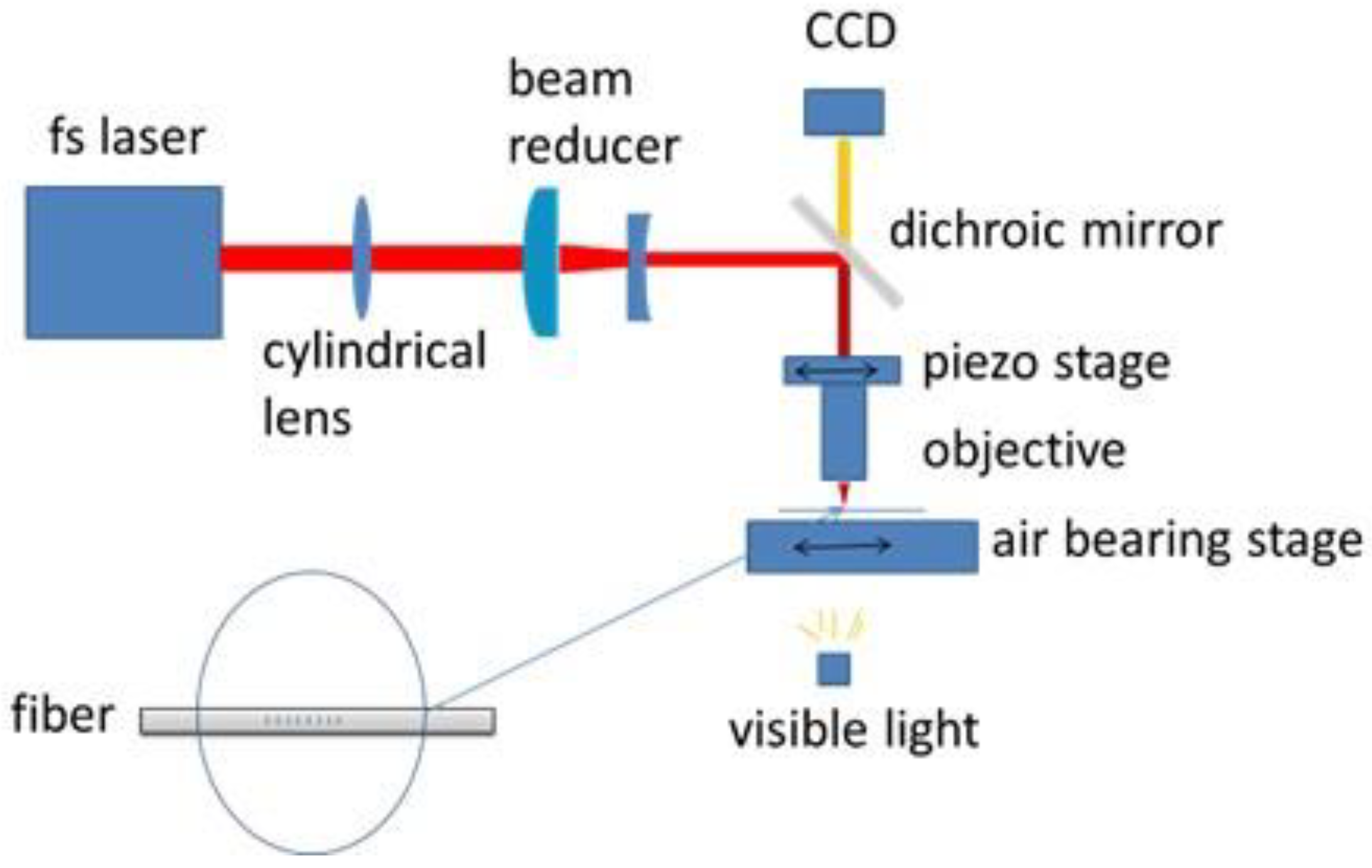

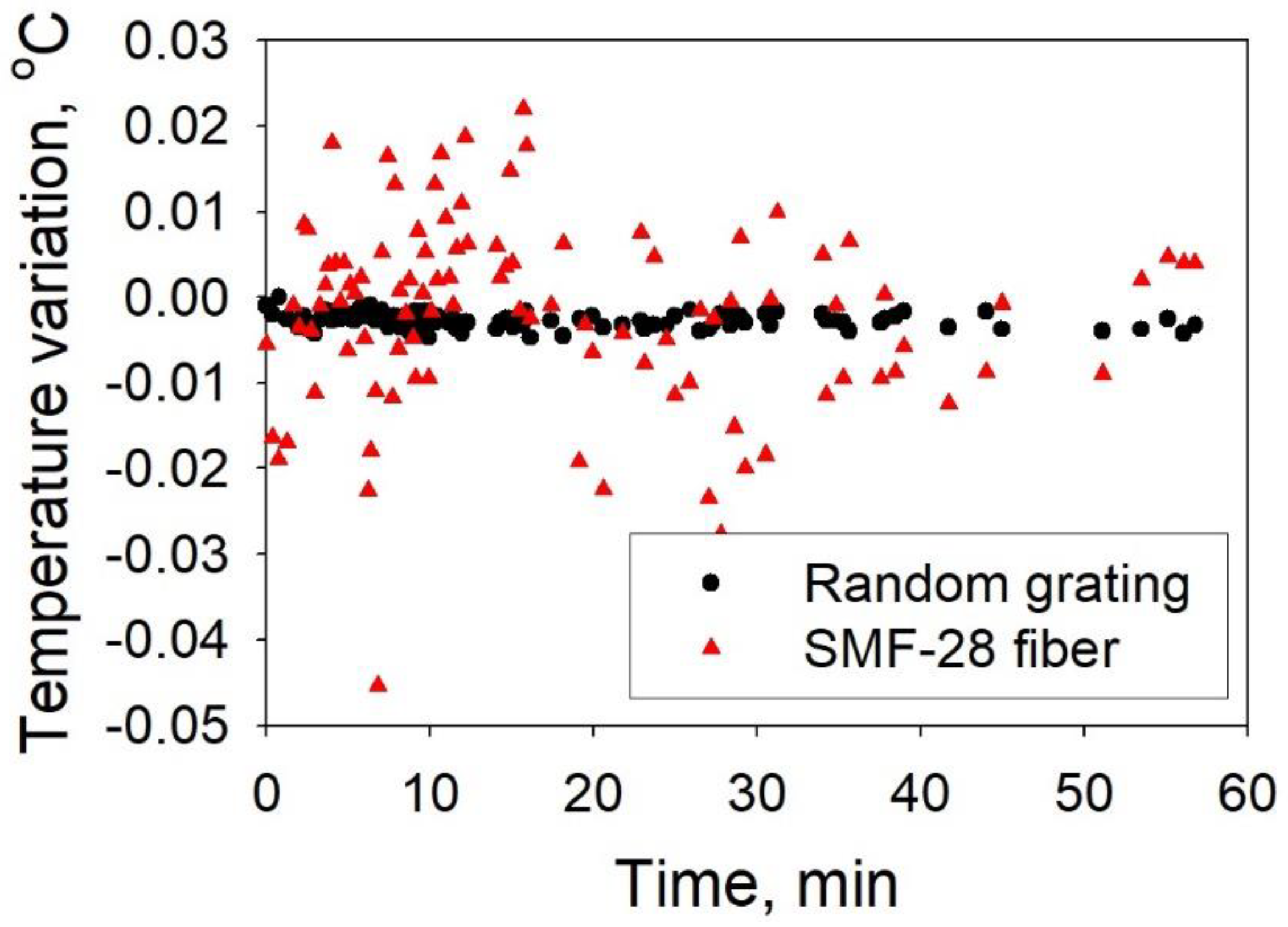
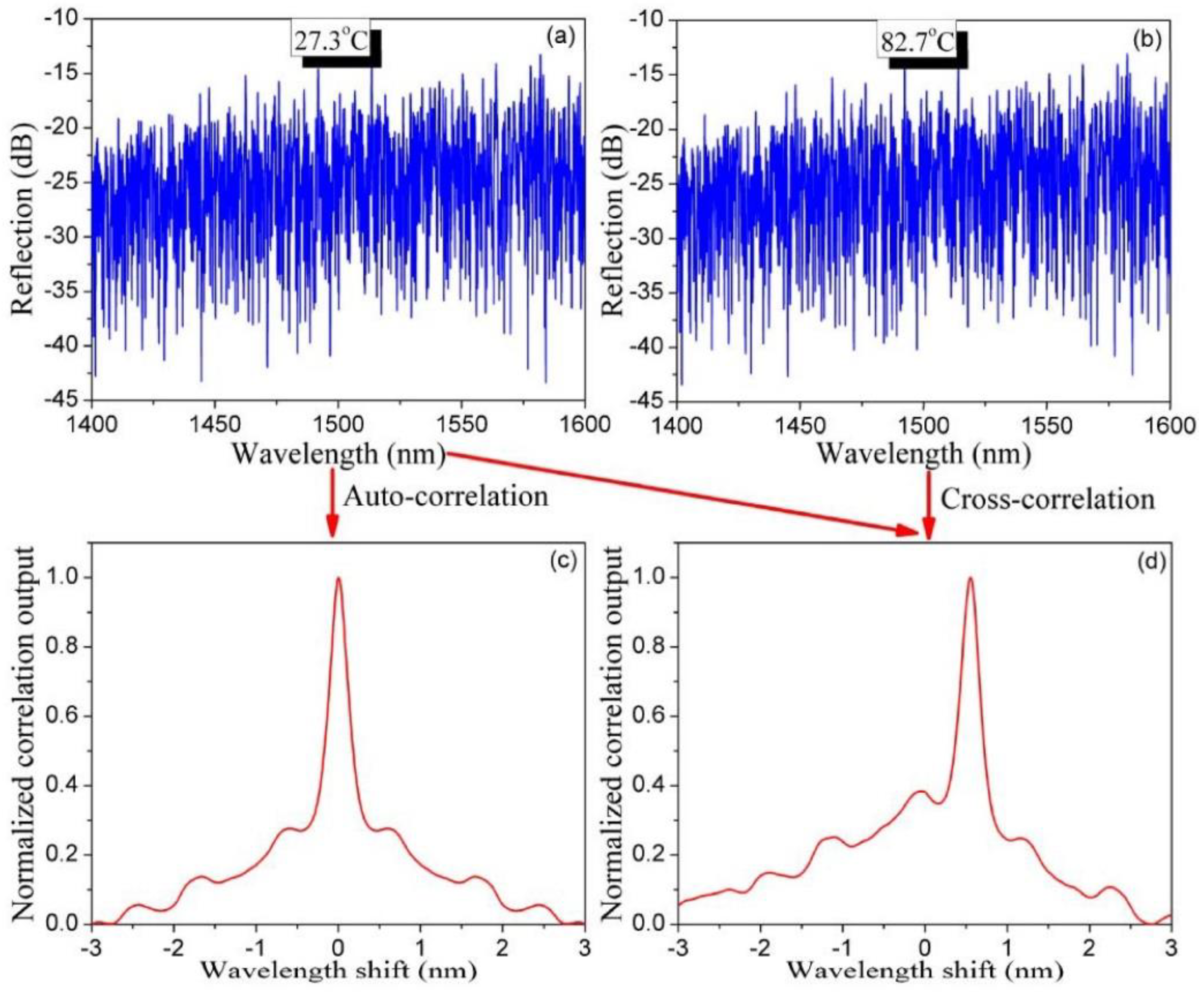
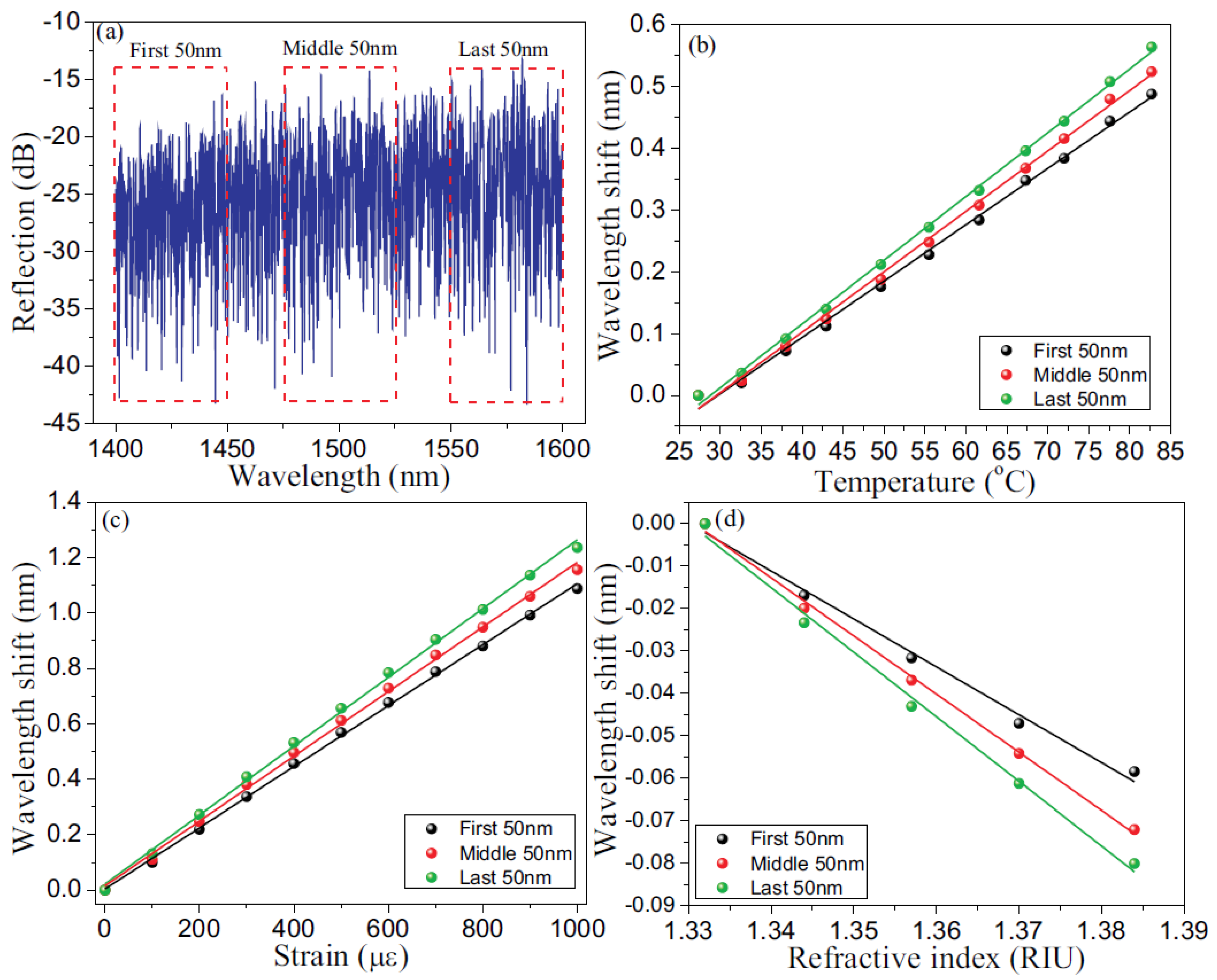
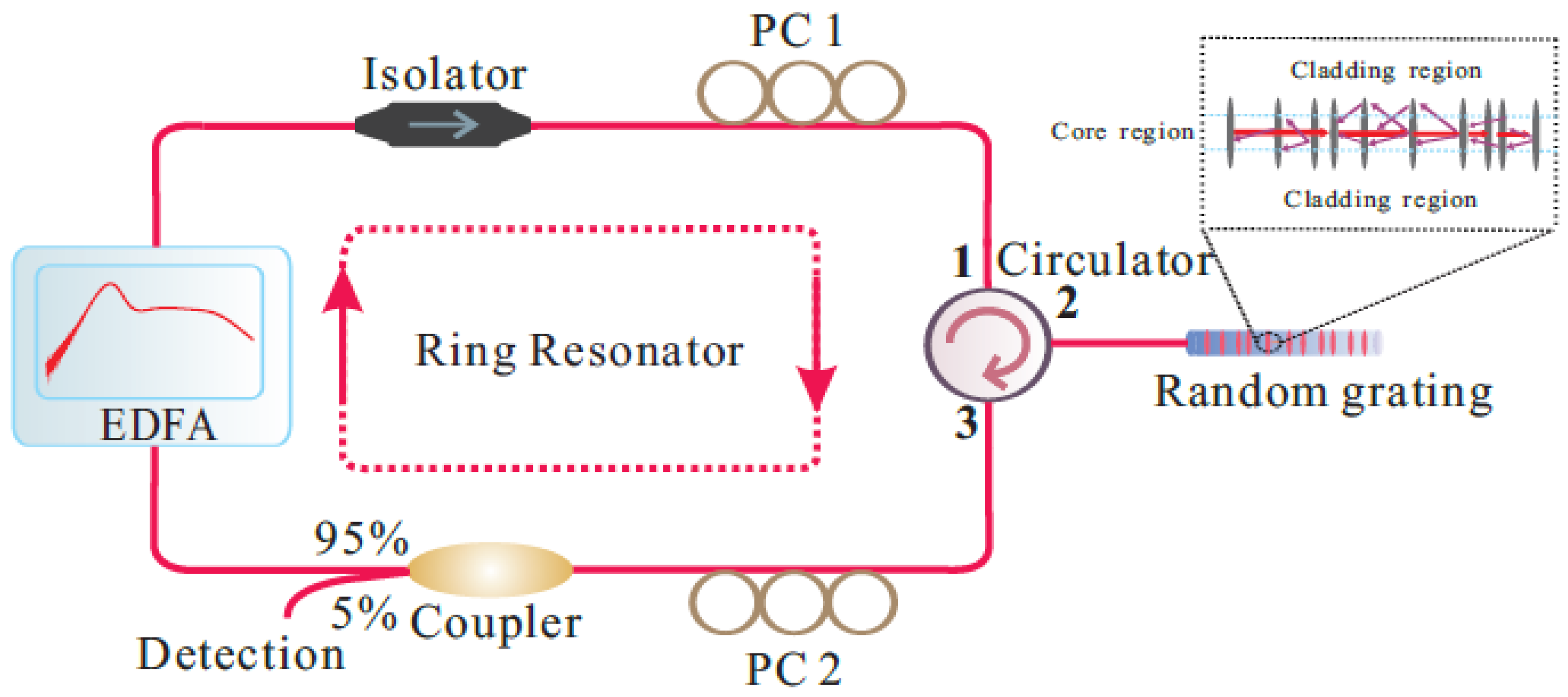

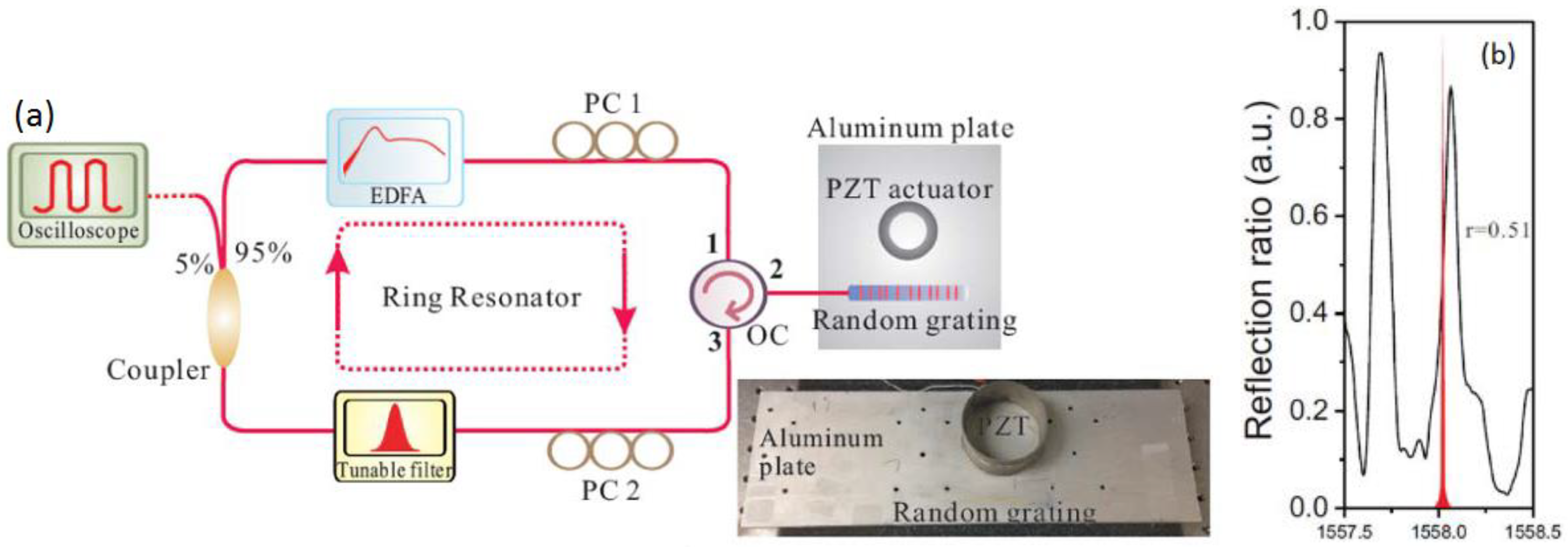
Publisher’s Note: MDPI stays neutral with regard to jurisdictional claims in published maps and institutional affiliations. |
© 2021 by the authors. Licensee MDPI, Basel, Switzerland. This article is an open access article distributed under the terms and conditions of the Creative Commons Attribution (CC BY) license (http://creativecommons.org/licenses/by/4.0/).
Share and Cite
Mihailov, S.J.; Hnatovsky, C.; Abdukerim, N.; Walker, R.B.; Lu, P.; Xu, Y.; Bao, X.; Ding, H.; De Silva, M.; Coulas, D.; et al. Ultrafast Laser Processing of Optical Fibers for Sensing Applications. Sensors 2021, 21, 1447. https://doi.org/10.3390/s21041447
Mihailov SJ, Hnatovsky C, Abdukerim N, Walker RB, Lu P, Xu Y, Bao X, Ding H, De Silva M, Coulas D, et al. Ultrafast Laser Processing of Optical Fibers for Sensing Applications. Sensors. 2021; 21(4):1447. https://doi.org/10.3390/s21041447
Chicago/Turabian StyleMihailov, Stephen J., Cyril Hnatovsky, Nurmemet Abdukerim, Robert B. Walker, Ping Lu, Yanping Xu, Xiaoyi Bao, Huimin Ding, Manny De Silva, David Coulas, and et al. 2021. "Ultrafast Laser Processing of Optical Fibers for Sensing Applications" Sensors 21, no. 4: 1447. https://doi.org/10.3390/s21041447
APA StyleMihailov, S. J., Hnatovsky, C., Abdukerim, N., Walker, R. B., Lu, P., Xu, Y., Bao, X., Ding, H., De Silva, M., Coulas, D., & Grobnic, D. (2021). Ultrafast Laser Processing of Optical Fibers for Sensing Applications. Sensors, 21(4), 1447. https://doi.org/10.3390/s21041447







